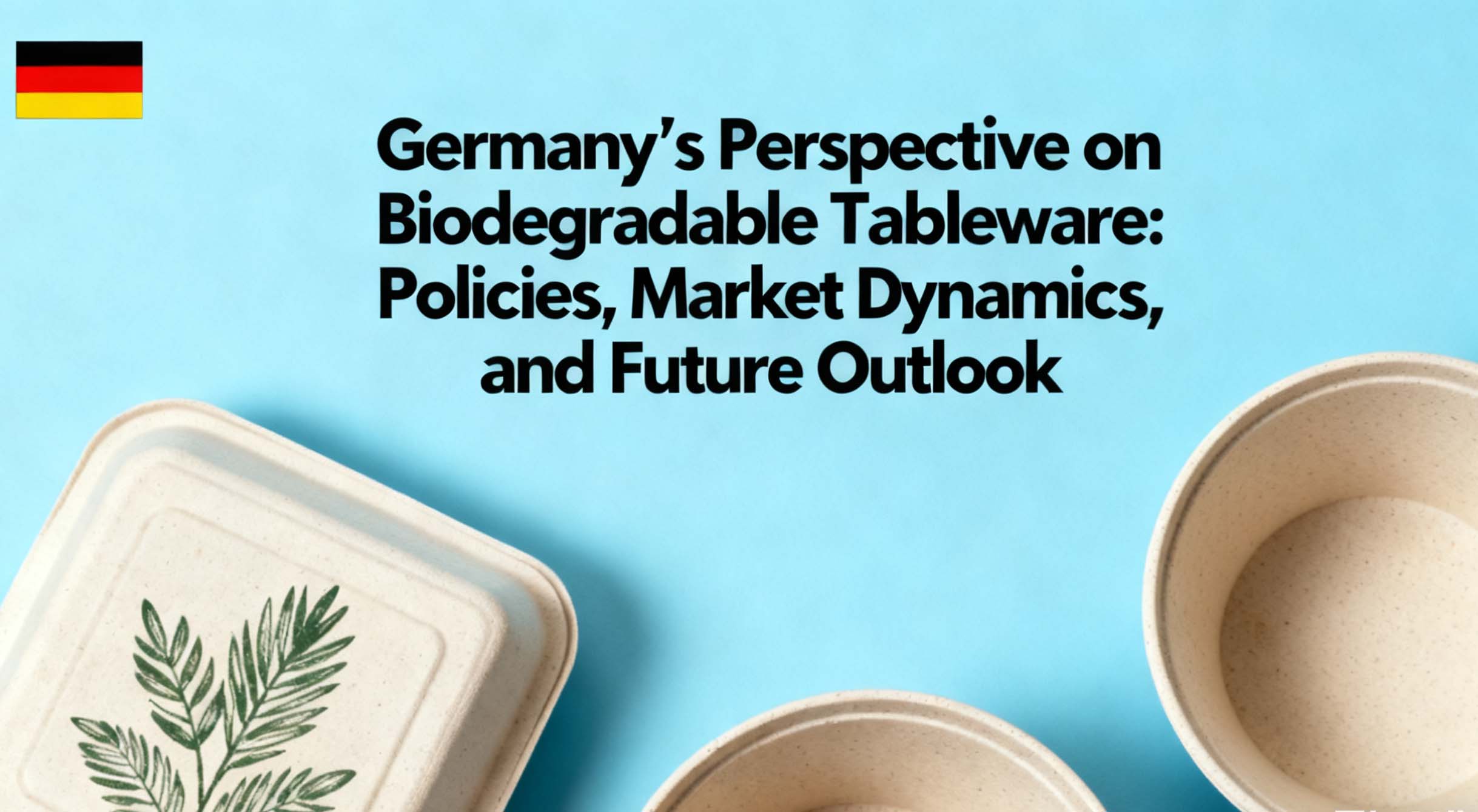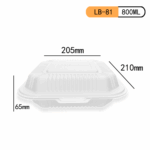Germany is embracing biodegradable tableware as part of its transition away from single-use plastics. Driven by EU directives, consumer demand, and industry innovation, bagasse, cornstarch, and wood-based products are gaining traction. Experts stress proper certification, composting infrastructure, and the growing role of reusable systems for long-term sustainability.

Introduction
Germany has long been recognized as a global leader in environmental policy and sustainable development. With its strong recycling culture, strict waste management laws, and high public awareness, the country has set benchmarks in Europe and beyond for transitioning away from single-use plastics. One important area within this shift is the adoption of biodegradable tableware—products made from renewable resources such as sugarcane bagasse, corn starch, and wood pulp.
This article explores Germany’s perspective on biodegradable tableware, including governmental regulations, consumer attitudes, market developments, expert opinions, and the potential challenges and opportunities in the years ahead.
1. Policy and Regulatory Framework
Germany’s approach to biodegradable tableware is deeply rooted in European Union (EU) legislation. The EU Single-Use Plastics Directive (SUPD), which came into effect in 2021, banned items such as plastic cutlery, plates, straws, and expanded polystyrene containers. Germany implemented these rules quickly, positioning itself among the strongest advocates for reducing plastic pollution.
At the national level, Germany has enacted further measures:
- Verpackungsgesetz (Packaging Act): Requires producers to register packaging materials, contribute to recycling schemes, and ensure more sustainable design.
- Deposit-return system (Pfand): Encourages consumers to return beverage containers for reuse or recycling, reinforcing a circular economy mindset.
- Restrictions on plastic bags and lightweight packaging: Pushed retailers and foodservice operators to switch toward biodegradable or reusable alternatives.
While the legislation does not explicitly favor biodegradable products over reusables, the bans on plastics have created fertile ground for biodegradable tableware producers to thrive. The government generally promotes material efficiency and life-cycle sustainability, emphasizing that biodegradable items must be genuinely compostable under industrial standards.
2. Market Landscape and Industry Adoption
Germany’s foodservice, catering, and retail industries have responded actively to policy changes and consumer pressure. Restaurants, cafeterias, and takeout services increasingly rely on biodegradable plates, cutlery, and containers. Supermarkets and organic grocery chains—such as Alnatura and Bio Company—offer biodegradable tableware for household use, often marketed as a premium, eco-conscious choice.
Several trends define the German market:
- Growth of Bagasse Products: Sugarcane bagasse trays and clamshells are especially popular due to their durability, heat resistance, and natural look.
- Cornstarch-Based Cutlery and Cups: Favored for their similarity to plastic but with compostable properties.
- Wooden and Paper-Based Utensils: Widely used in fast-food and street-food contexts, particularly where quick disposal is expected.
- Bioplastics (PLA): Used in cold beverage cups and salad containers, although Germany maintains strict scrutiny regarding biodegradability claims.
Industry players emphasize transparency, with certifications such as DIN EN 13432 (compostability standard) playing a central role. Products without clear certification often face skepticism from both regulators and consumers.
3. Consumer Perspectives
German consumers are highly environmentally aware and tend to support sustainable alternatives. Surveys consistently show that Germans are willing to pay more for eco-friendly packaging, although price sensitivity remains a factor. Biodegradable tableware appeals particularly to younger demographics and urban populations, who connect sustainable consumption with personal responsibility and lifestyle identity.
Key insights into consumer attitudes:
- Trust in Certification: Consumers demand proof of compostability; without reliable certification, claims of “eco-friendly” are often dismissed as greenwashing.
- Preference for Natural Materials: Items made from bagasse, bamboo, or wood are often perceived as more authentic than synthetic bioplastics.
- Practical Considerations: Durability, leak-resistance, and safe use with hot foods remain important; flimsy biodegradable products struggle to gain acceptance.
- Waste Separation Culture: Germans are accustomed to separating organic, plastic, paper, and residual waste. This habit supports acceptance of biodegradable packaging if it clearly fits into the organic waste stream.
4. Expert Opinions and Criticism
While biodegradable tableware enjoys strong public and political support, experts offer nuanced perspectives:
- Environmental Scientists emphasize that not all biodegradable products break down effectively in natural environments. Most require industrial composting facilities, which may not be accessible everywhere.
- Waste Management Authorities warn that contamination of composting systems with non-certified items creates operational challenges. They advocate stricter labeling and consumer education.
- Economists and Industry Analysts highlight that while biodegradable products reduce plastic waste, they may not always outperform reusable solutions in terms of overall carbon footprint.
- NGOs such as Deutsche Umwelthilfe (DUH) argue that the ultimate goal should be reuse systems—such as deposit-based takeout containers—rather than single-use biodegradable items.
Thus, while biodegradable tableware is welcomed as a transitional solution, experts stress that it should not distract from broader systemic shifts toward circular economy practices.
5. Case Studies
- Berlin’s Foodscene: Many street-food vendors in Berlin, known for their multicultural culinary offerings, have adopted bagasse clamshells and wooden cutlery, aligning with the city’s progressive environmental culture.
- University Canteens: German universities, such as those in Freiburg and Munich, have piloted biodegradable trays and cutlery alongside reusable systems, balancing convenience with sustainability.
- Festivals and Events: Large-scale gatherings like Oktoberfest have trialed biodegradable beer cups and plates, though organizers still debate whether reusable cups deliver a lower environmental impact.
These examples demonstrate Germany’s pragmatic approach: testing biodegradable solutions while keeping reusability as the long-term vision.
6. Challenges and Limitations
Despite progress, several challenges remain:
- Composting Infrastructure: Not all regions have sufficient industrial composting facilities, meaning biodegradable items may end up in incineration plants.
- Consumer Confusion: Misunderstandings about what is biodegradable, compostable, or recyclable can undermine the effectiveness of waste systems.
- Cost Barriers: Biodegradable tableware often costs significantly more than plastic, posing difficulties for small businesses.
- Supply Chain Issues: Dependence on agricultural byproducts (e.g., sugarcane bagasse) raises concerns about supply stability and transport emissions.
7. Future Outlook
Germany’s future with biodegradable tableware is likely to be defined by three parallel developments:
- Integration with Circular Systems: Biodegradable products will increasingly be paired with advanced composting systems, ensuring proper disposal.
- Stricter Standards and Labeling: Authorities will enforce tighter rules to eliminate misleading green claims and enhance consumer confidence.
- Shift Toward Reuse Models: Biodegradable tableware will serve as a bridge, but long-term strategies will favor reusable containers supported by digital deposit systems and smart logistics.
Germany’s broader Green Deal commitments and climate targets will continue to shape this transition, making biodegradable tableware an important—though not ultimate—piece of the sustainability puzzle.
Conclusion
Germany’s perspective on biodegradable tableware reflects its environmental ethos: ambitious in policy, critical in scientific evaluation, and deeply influenced by consumer responsibility. While biodegradable products are welcomed as alternatives to single-use plastics, they are not seen as a final solution. Instead, they are part of a broader pathway toward a circular economy where reusability and waste prevention take precedence.
In this way, Germany offers a model for balancing innovation with critical evaluation—embracing biodegradable tableware where it makes sense, but never losing sight of the larger sustainability goals.
FAQ on Germany’s Perspective on Biodegradable Tableware
Q1. Is biodegradable tableware legally required in Germany?
No, biodegradable tableware is not legally mandated. However, Germany enforces the EU Single-Use Plastics Directive, which bans many plastic disposables, creating demand for biodegradable alternatives.
Q2. Are all biodegradable products in Germany truly compostable?
Not necessarily. Only products certified under standards such as DIN EN 13432 are guaranteed to decompose in industrial composting facilities. Non-certified items may not fully degrade and could be rejected by waste processors.
Q3. Do German consumers prefer biodegradable tableware over plastic?
Yes, surveys indicate strong consumer preference for eco-friendly alternatives. However, trust in certification and product durability are essential factors influencing adoption.
Q4. What materials are most popular in Germany for biodegradable tableware?
Sugarcane bagasse, cornstarch-based bioplastics, wood, and paper are the most widely adopted materials. PLA is used in certain cases but faces scrutiny due to composting challenges.
Q5. How does Germany balance biodegradable tableware with reusable solutions?
Experts and NGOs argue that reusables should be prioritized. Biodegradable options are seen as a transitional solution, especially for large events, catering, and takeaway services where reusables are less practical.
Q6. What challenges exist for biodegradable tableware in Germany?
Key challenges include limited composting infrastructure, higher costs, supply chain dependencies, and consumer confusion about proper disposal.
Q7. What is the future outlook for biodegradable tableware in Germany?
The market will likely expand in the short term, but stricter standards, integration with composting systems, and the rise of reusable deposit schemes will shape long-term strategies.
References and Further Reading
- European Commission – Single-Use Plastics Directive (SUPD):
https://environment.ec.europa.eu/topics/plastics/single-use-plastics_en - German Packaging Act (Verpackungsgesetz – VerpackG):
https://www.verpackungsregister.org - DIN EN 13432 Compostability Standard (Overview):
About standards - Deutsche Umwelthilfe (DUH) – NGO campaigns on packaging and waste:
https://www.duh.de - German Federal Ministry for the Environment, Nature Conservation, Nuclear Safety and Consumer Protection (BMUV):
https://www.bmuv.de - Statista – Market data on biodegradable packaging in Germany:
https://www.statista.com/topics/5854/bioplastics-in-europe - European Bioplastics e.V. – Industry perspectives:
https://www.european-bioplastics.org - Fraunhofer Institute for Environmental, Safety, and Energy Technology (UMSICHT) – Research on bioplastics:
https://www.umsicht.fraunhofer.de
Copyright Statement
© 2025 Dashan Packing. All rights reserved.
This article is an original work created by the Dashan Packing editorial team.
All text, data, and images are the result of our independent research, industry experience,
and product development insights. Reproduction or redistribution of any part of this content
without written permission is strictly prohibited.
Dashan Packing is committed to providing accurate, evidence-based information and
to upholding transparency, originality, and compliance with global intellectual property standards.





